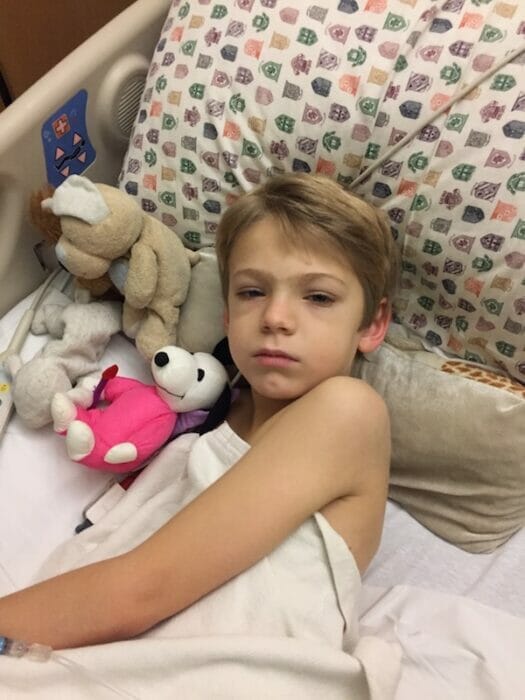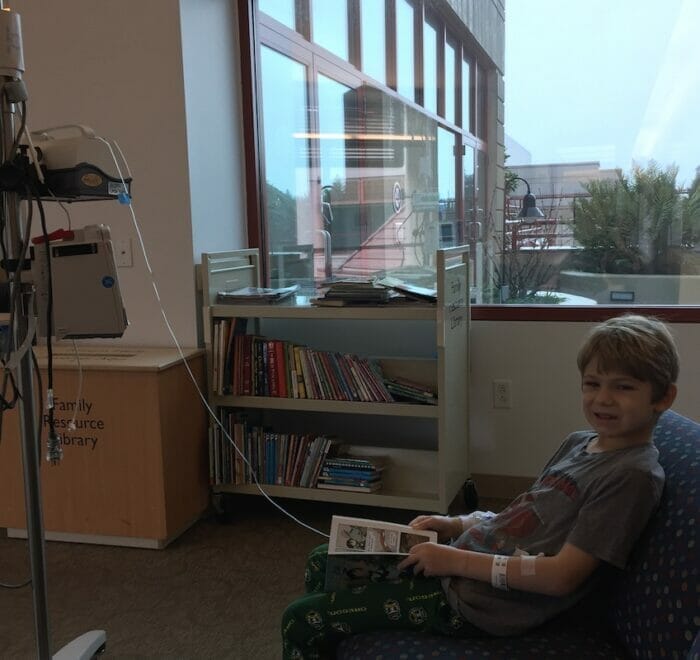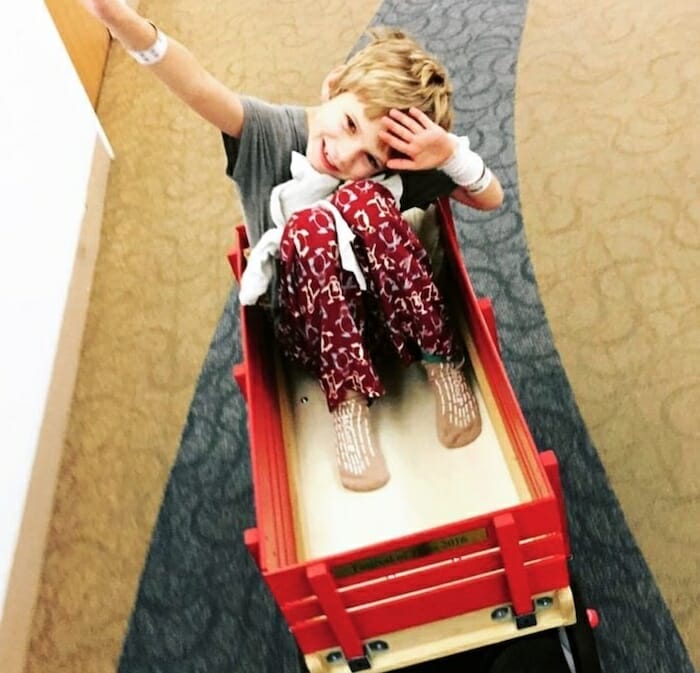Maybe it’s the 24-hour flu.
This is what Erin Simmons initially thought when her 8-year-old son Trevor’s school called her late in the morning on Jan. 25, 2017. “He doesn’t look good,” the nurse said. Simmons cut out of a conference call early to pick him up.
It was a Wednesday. And it was flu season. The germs were flying.
Her older son, MJ, 12, had a cold the prior week, and Simmons figured Trevor caught that or some kind of stomach virus that was keeping kids home sick. “He felt like he was going to faint and had immediate, violent stomach cramping and turned pale,” Simmons described of his condition when she ushered him to the car. They went straight back to their home in San Jose, Calif.
The Simmons family had always been conscientious about what they stock in their pantry and serve at the dinner table. When MJ was a toddler, he had an allergic reaction to a macadamia nut. “We got EpiPens and avoid nuts,” she said matter-of-factly.
Sampling various nut butter alternatives, the family found their favorite: I.M. Healthy by The SoyNut Butter Company, manufactured by Dixie Dew. The kids loved it smeared on bagels or toast, and it had become a staple for years — since before Trevor was even born.

Never did a thought of the actual “safety” of this soy nut butter cross Simmons’ mind. She didn’t think for a second that the jar sitting in the shelf at eye-level was the culprit of a devastating downward spiral due to the most violent and potentially fatal form of E. coli — 0157:H7, a Shiga toxin-producing strain.
Trevor has always been a kid who’s lucky in life. He finds coins on the ground — one time a 1943 Mercury dime made of 90% silver in the Safeway parking lot. He loves tennis and speaks French, having attended an immersion school when he was younger. He’s an enterprising kiddo. Simmons shares how before the holiday break, he and a few classmates were offering singing and dancing lessons for .25 cents.
But there is another side to being an unlikely “winner.” Sadly, Trevor and others impacted by the soy nut butter recall fought to survive while the product remained for sale on store shelves.
Once home, Trevor wore a path from his bedroom to the bathroom, getting sick every 45 to 90 minutes — cramping, soreness, exhaustion. Stools were then bloody, and Simmons was on an around-the-clock rotation of cleaning and care.
Saltines and toast, Pedialyte — Simmons was doing all the things parents do when a child is sick. It wasn’t working. By Thursday, Trevor was vomiting and still could not keep anything inside. “But he was talking and did not have a fever,” she said. “I was trying to nurse him back to health. I was sleeping in his room.”
His condition worsened. Saturday morning, Simmons packed up Trevor, extra clothing and towels and drove to the pediatrician’s office. “There is something else going on,” she told the doctor. Trevor could not sit on the table in the exam room long enough for an observation. He couldn’t walk from the car to the office without having an accident.
The doctor said, “He needs to go to the E.R. Do you want me to call an ambulance, or can you take him?”
Simmons drove her son to nearby Good Samaritan Hospital after calling to be sure there was a bed open for him. A CT scan revealed no blockages. Stool samples were sent to the lab.
“They thought Trevor had an unknown bacteria that was causing his digestive system to be completely inflamed. Maybe it was colitis or Crohn’s, but they had no idea what was causing the problem,” Simmons said.
Simmons dialed back to the past few days’ dinner menus. Could it have been food poisoning? They had been ordering prepped box meals, had pizza at Whole Foods and ate their usual breakfast fare — toast, bagels and either cream cheese or soy nut butter on top.
She had no idea.
Trevor could stay overnight in the hospital for results, but he was not dehydrated, and his vitals were still strong. The hospital told Simmons it was fine for him to go home. So they did.
“We were waiting and waiting on those stool test results,” Simmons said, adding that doctors suggested Tylenol every four to six hours and Benefiber to soak up the liquid his body was retaining at this point.
On Sunday, Trevor refused to eat or drink anything. “His tummy hurt too much, and he was tired of having diarrhea,” Simmons said.
Trevor told her, “I am so done, mom.”

On Monday morning, Simmons called the pediatrician’s office for the stool test results. They still were not available. Another trip to the doctor’s office led to admitting Trevor again to the local hospital for an IV of fluids. There, he was on alternate courses of morphine and Benadryl to manage the extreme pain.
Simmons had questions. There were no answers.
Symptoms were evolving as he retained fluid and became disoriented, agitated and anxious — he was hallucinating, throwing tantrums. He was not Trevor at all. “It hurt him to get out of bed,” Simmons said. “His ankles and feet hurt to the touch, and he had a constant headache. He was confused.”
Finally, on Tuesday — nearly a week after the school sent Trevor home sick — the stool test results arrived. Trevor was diagnosed with E. coli 0157:H7 and had kidney and renal failure with a condition called hemolytic uremic syndrome (HUS). This meant the small blood vessels in his kidneys were damaged and inflamed, causing clots that clog the kidney’s filtering system. HUS leads to life-threatening kidney failure, and it is often caused by infection with certain strains of E. coli. The traumatic cascade of symptoms usually begins with several days of non-bloody diarrhea.
“We figured out what made him sick,” the doctor explained. Except there was no explanation for why Trevor contracted a potentially deadly form of E. coli. The family was advised by an empathetic, experienced nurse and a pediatric gastroenterologist from Stanford Children’s Health, Dr. Adel Abi-Hanna, that Trevor needed a nephrologist and dialysis — right away.
Transferring hospitals isn’t as simple as hopping in an ambulance. Navigating departmental communications and diagnoses and test results and what-ifs is like picking up a research digest written in a language you don’t know. The entire devastating ordeal was overwhelming.
Later that week, Simmons’ husband Mosby rode with their son on the journey to the Pediatric Intensive Care Unit (PICU) — none of them realizing that he would stay there for 21 days. MJ had been away on a class trip to Yosemite National Park and was not yet aware of Trevor’s condition. He was due to return the next day.
By the time Trevor arrived at Stanford, he was completely anemic. Blood clots the size of an egg poured from his nose. His extremities were swelling, his potassium levels were dangerously high, and he could not go to the bathroom despite the urge. He got a catheter. IVs failed and were painfully replaced.
“I could not believe my child was so sick he needed blood transfusions — he was this sick, I kept thinking. How could he be this sick?” Simmons said. She and Mosby were terrified.
“Trevor was no longer Trevor.”
Trevor needed dialysis — the first of several infusions — and he was in isolation. Family, classmates and teachers visited, suiting up so they could be with him. He moved out of the PICU to the cardiac floor to the kidney unit, where he eventually shared a room.
“His room was a constant cycle of new patient, discharge, clean room, new patient,” Simmons said, describing the revolving door of roommates, in and out. When would it be Trevor’s turn? “He seemed distant and depressed,” she said, relating how her son would watch the same movies over and over again.
Visitors from school kept Trevor’s spirits up. “They read to him, joked with him,” Simmons said. Trevor Skyped into the class Valentine’s Day party. Meanwhile, he had to start eating, drinking and walking.
“I brought my mini ice chest with his favorite snacks inside,” Simmons said. Those included grapes, yogurt squeezes, slices of pizza from his favorite parlor and a jar of I.M. Healthy soy nut butter to spread on toast. “Thank God he refused it and everything else in the cooler. He wouldn’t eat anything.”

Simmons’ best friend visited and brought Trevor a bag of Doritos. He ate three of them — a major victory after being on IV nutrition. The Simmons family made a game out of finding Doritos throughout the hospital at the cafe and vending machines.
Eventually, Trevor could attend the school within Stanford Children’s Hospital, where he made friends. “He needed to start walking to get his strength back,” Simmons said, relating that she would bring a wagon along in case he needed a ride back to his room.
They measured every millimeter of fluids Trevor consumed and urinated. Eventually, the catheter was removed.
“It was like he became attached to it. He didn’t want it to go away at first and was worried he would have a hole in his chest,” Simmons said.
Trevor climbed a rugged mountain toward recovery. Toward the end of February, the goal was to stabilize potassium levels so he could return home. But before that, the Simmons family scoured the house. They still had no idea what had introduced the E. coli.
“We went on a cleaning binge and were so worried that we did something wrong that caused this,” Simmons said. “We have two fridges. We threw out everything, scrubbed everything. I paid a specialty cleaning company to have the house professionally disinfected. It was like having HAZMAT. Except the culprit was still in my pantry.”
Trevor went home on Feb. 23. About a week later, Simmons got a call from Santa Clara County Health. They provided a list of items that were common matchups to Trevor’s illness based on data they had collected. One of them was I.M. Healthy soy nut butter.
“I told them, ‘I have this in my house!’”
The next day, an official drove to the Simmons’ home to pick up the jar of I.M. Healthy and then went shopping. “She bought up as much of it as she could. She went all over with a refrigeration truck.”
Simmons remembered purchasing her jar on Jan. 14. She still had the receipt. Trevor had consumed half of it before getting sick, and no one else in the family had eaten from that container.
An investigation unfolded, led by the FDA, CDC, state and local health officials. The Simmons family connected with Bill Marler, attorney with Marler Clark, a firm focused on foodborne illness outbreaks. By the time Trevor got home from the hospital, 12 others were infected in the multi-state outbreak, and the numbers grew from there.
Simmons was appalled at the state of the I.M. Healthy facility when she read the reports. “Overall, we were like, ‘How the hell were they able to be part of the food business? They should never have been in business.’”

Months after the news story broke and the FDA issued a recall, I.M. Healthy soy nut butter was still on some store shelves. In fact, a friend texted a photo of the jars that were on sale. “It had been on a recall, and the store was still selling it in the fall.” Amazon still had it for sale online, a food safety researcher discovered.
Now, grocery shopping comes with a degree of uncertainty Simmons tries to hush.
“I will buy. I’m always going to buy. But in the U.S., we should be able to trust that what we buy is not going to make us sick. What will food companies do to make sure we can trust what we purchase? As consumers, we have the power to make decisions.”
Meanwhile, the devastation and disease left their family to put the pieces back together. They do not know if Trevor will have permanent kidney damage. But they’re living each day forward. “This changed the trajectory of our lives, and it could have been prevented,” Simmons said.
Still, she added, “After being hit with something unknown and out of our control, the doctor encouraged us again and said, ‘That’s life. Keep living.’”
About a year after the outbreak, I.M. Healthy filed for bankruptcy. According to Food Safety News, a bankruptcy court awarded victims $11.25 million.
In the end, Trevor did experience winning odds. He is a lucky kid, after all.
“Trevor was extremely fortunate,” Simmons said. “He kept his kidneys. They are functioning, and he got to keep them. We are so grateful. Like I tell Trevor, ‘You are the luckiest kid ever. You have your kidneys. You are going to move on, and you are going to do great things.’”
Trevor’s Story courtesy of Quality Assurance magazine, by Kristen Hampshire | June 2023



